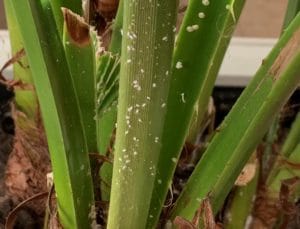Hello, fellow readers,
When I met with Suz of Sparta, NJ, to review a garden design, I saw her fiddlehead fig tree we spoke about last week standing tall in its new pot. She said it was rootbound, with very little soil, so repotting during winter was warranted (though not customarily suggested as it’s their time to rest). Suz asked about the mold on another house plant; I believe a Split Leaf Philodendron (Monstera deliciosa). “I’ve been wiping it off, but it keeps coming back,” she said.
Indeed, the fuzzy white specks looked like mold. I surmised they could be eggs or nymphs of whiteflies and suggested Neem Oil. It’s my go-to in the garden, so it makes sense to use it inside. There’s horticultural oil or insecticidal soap, but I vote for the old tried-and-true. Neem Oil is a natural alternative extracted from the Neem tree (Azadirachta indica) native to India. Its antibacterial and antiseptic attributes discourage both fungi and parasites.
Mealybugs and whiteflies look similar.
When I returned home and zoomed in on the photo of Suz’s Philodendron dilemma, I realized it could be mealybugs. The good news is the remedy is similar.
Both mealybugs and whiteflies are white, though some mealybugs are cream-colored, even brownish. The fuzzy, cottony-looking mealybugs don’t fly, whereas adult whiteflies do. Both suck sap, causing curling and yellowing leaves and are stealthy in finding their way inside.
Both mealybugs and whiteflies are stealthy.
I noticed a beautiful bouquet of lilies on the dining room table. Suz enjoys fresh flowers each week, she said. Mealybugs and whiteflies are frequent greenhouse guests, so the cut flowers could be the culprit.
They can also hide in produce from the grocery or veggie garden. And houseplants that spend the summers outside can bring them in. Sometimes, they come home with a new plant.
Separate the infected plant from others. If you can fit the plant in the shower or sink, rinse it off. I read you can use cotton swabs with rubbing alcohol to kill mealybugs, though I wonder about the impact on the plant. For sure, use it on the nooks, crannies, and bottom of the pot where critters can hide.
Safe remedies of good riddance.
Let the plant dry, then spray Neem Oil periodically until all the evidence of the invasion is gone. The whiteflies will fly when you spray them, but it will kill the eggs and nymphs. Be sure to spray the underside of leaves where they lay their eggs — sneaky little buggers.
Vacuuming up whiteflies is effective if you are careful around the foliage. Then hang sticky tape, the kind for house flies works fine.
If the darn things keep coming back, remove the top two inches of soil where they could be living. Clean the inside of the pot with rubbing alcohol then top-dress with fresh potting soil.
It takes time, weeks, even months, and several applications to get ahead of the stealth little buggers. Patience is a virtue. And, an achievement!
Garden Dilemmas? AskMaryStone@gmail.com (and now on your favorite Podcast App.)
Tip: You can make insecticidal soap using one teaspoon of mild liquid soap (preferably organic) mixed with four cups of water. Add 1.5 teaspoons of Neem Oil to the mix is even better. Bonus—Neem Oil acts as a repellent for whiteflies!
More about Neem Oil in Finding Neem Oil
About Suz’s Fiddleheadfig Tree.




I have the white flies in my back yard and they have made my outdoor life unbearable. They have consumed my trees, leaving many of my other plants and bushes covered in black muck. I have sprayed neem oil mixed with dish soap countless times. As far up the trees as I can 2 of the trees are at least 100 ft. It looks like it’s snowing I’m at my wits end
Hi Donna, I’ve never heard of a significant outdoor infestation like yours! It MUST be unbearable. I’ve read that beneficial insects such as parasitic wasps and black lady beetles may help, but not when the problem is severe, such as yours.
Perhaps reach out to your local extension office to see what they recommend. Or a certified arborist. Areas with mild winters allow the white flies to reproduce all year round. What a dilemma! I wish I could offer more help… Thank you for reading my blog, and keep me posted! Mary Stone
Thank you Mary. I did reach out to both the township and the Arbor group, they recommended the neem oil.
Hi Donna, I’m a fan of Neem Oil, too, but from your description, it sounds like it would be best to hire a tree expert who can apply it systematically (one application is likely not enough) and reach the heights of your trees. Or use whatever other natural and safe product they suggest. I hope you can solve your unbearable dilemma! Thank you again for reading my blog, Mary Stone